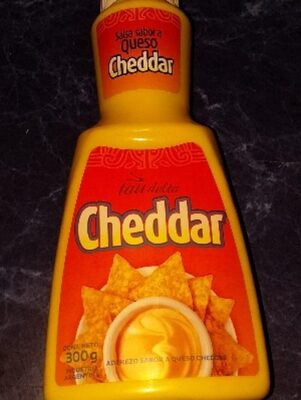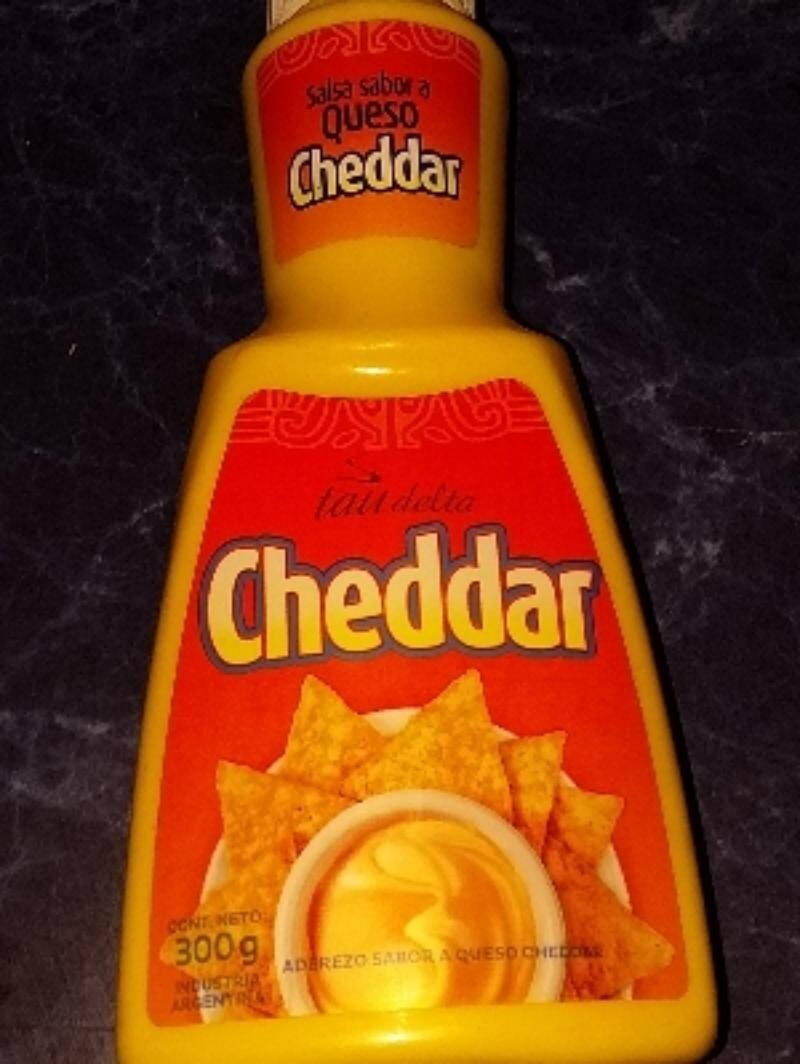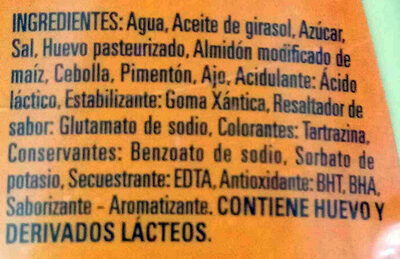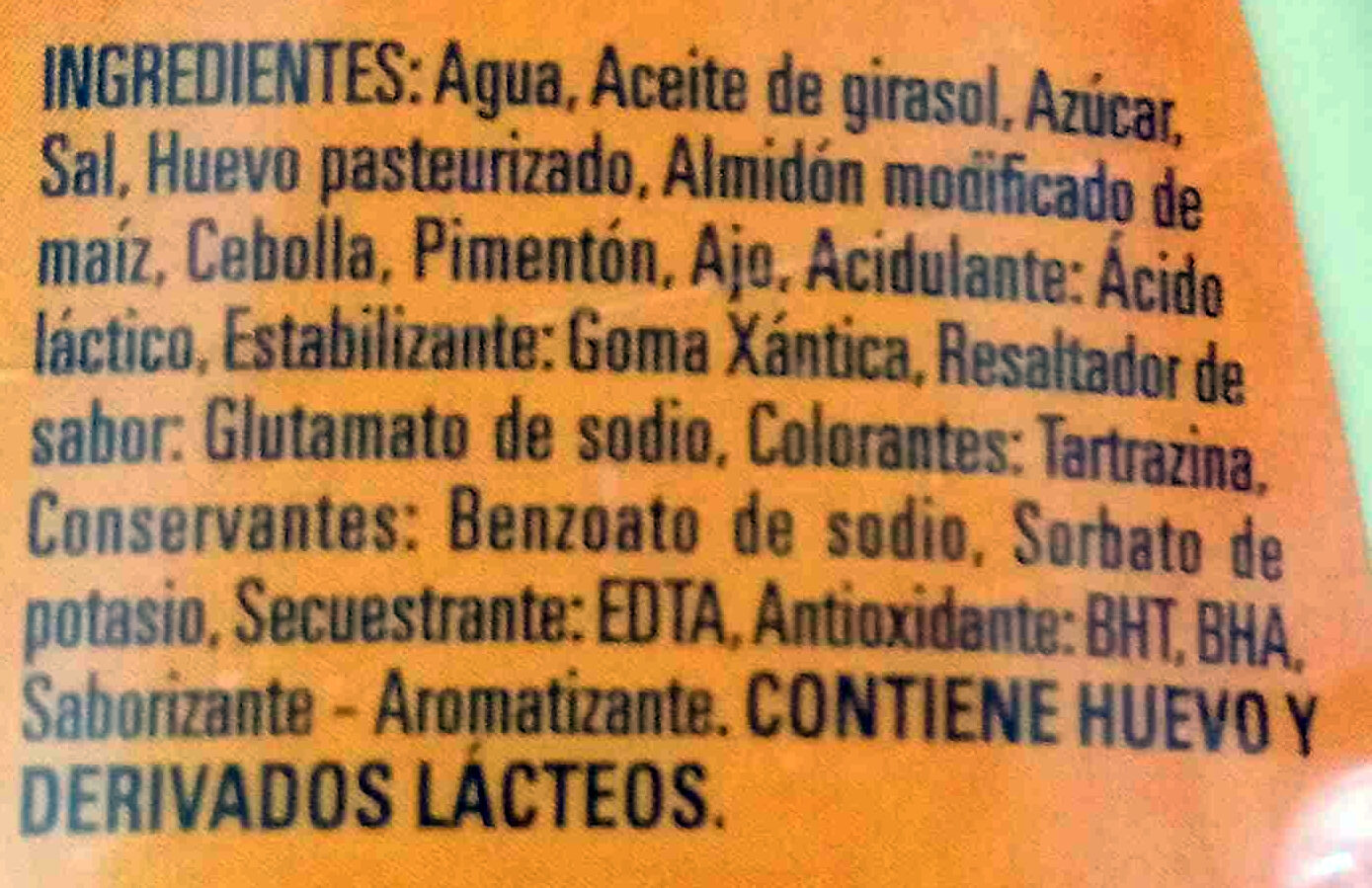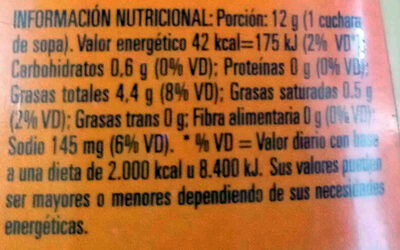Help us make food transparency the norm!
As a non-profit organization, we depend on your donations to continue informing consumers around the world about what they eat.
The food revolution starts with you!
Salsa sabor cheddar - Tau Delta
Salsa sabor cheddar - Tau Delta
This product page is not complete. You can help to complete it by editing it and adding more data from the photos we have, or by taking more photos using the app for Android or iPhone/iPad. Thank you!
×
Barcode: 7798146130370 (EAN / EAN-13)
Packaging: es:Botella plástica
Brands: Tau Delta
Categories: Condiments, Sauces, Cheese sauces, Groceries
Matching with your preferences
Health
Ingredients
-
26 ingredients
: Agua, Aceite de girasol, Azúcar, Sal, Huevo pasteurizado, Almidón modificado de maíz, Cebolla, Pimentón, Ajo, Acidulante: Acido láctico, Estabilizante: Goma Xántica, Resaltador de sabor: Glutamato de sodio, Colorantes: Tartrazina. Conservantes: Benzoato de sodio, Sorbato de potasio, Secuestrante: EDTA, Antioxidante: BHT, BHA, Saborizante-Aromatizante.Allergens: Eggs
Food processing
-
Ultra processed foods
Elements that indicate the product is in the 4 - Ultra processed food and drink products group:
- Additive: E102 - Tartrazine
- Additive: E14XX - Modified Starch
- Additive: E621 - Monosodium glutamate
- Ingredient: Colour
- Ingredient: Sequestrant
Food products are classified into 4 groups according to their degree of processing:
- Unprocessed or minimally processed foods
- Processed culinary ingredients
- Processed foods
- Ultra processed foods
The determination of the group is based on the category of the product and on the ingredients it contains.
Additives
-
E102 - Tartrazine
Tartrazine: Tartrazine is a synthetic lemon yellow azo dye primarily used as a food coloring. It is also known as E number E102, C.I. 19140, FD&C Yellow 5, Acid Yellow 23, Food Yellow 4, and trisodium 1--4-sulfonatophenyl--4--4-sulfonatophenylazo--5-pyrazolone-3-carboxylate-.Tartrazine is a commonly used color all over the world, mainly for yellow, and can also be used with Brilliant Blue FCF -FD&C Blue 1, E133- or Green S -E142- to produce various green shades.Source: Wikipedia
-
E202 - Potassium sorbate
Potassium sorbate (E202) is a synthetic food preservative commonly used to extend the shelf life of various food products.
It works by inhibiting the growth of molds, yeast, and some bacteria, preventing spoilage. When added to foods, it helps maintain their freshness and quality.
Some studies have shown that when combined with nitrites, potassium sorbate have genotoxic activity in vitro. However, potassium sorbate is generally recognized as safe (GRAS) by regulatory authorities.
-
E211 - Sodium benzoate
Sodium benzoate: Sodium benzoate is a substance which has the chemical formula NaC7H5O2. It is a widely used food preservative, with an E number of E211. It is the sodium salt of benzoic acid and exists in this form when dissolved in water. It can be produced by reacting sodium hydroxide with benzoic acid.Source: Wikipedia
-
E270 - Lactic acid
Lactic acid: Lactic acid is an organic compound with the formula CH3CH-OH-COOH. In its solid state, it is white and water-soluble. In its liquid state, it is colorless. It is produced both naturally and synthetically. With a hydroxyl group adjacent to the carboxyl group, lactic acid is classified as an alpha-hydroxy acid -AHA-. In the form of its conjugate base called lactate, it plays a role in several biochemical processes. In solution, it can ionize a proton from the carboxyl group, producing the lactate ion CH3CH-OH-CO−2. Compared to acetic acid, its pKa is 1 unit less, meaning lactic acid deprotonates ten times more easily than acetic acid does. This higher acidity is the consequence of the intramolecular hydrogen bonding between the α-hydroxyl and the carboxylate group. Lactic acid is chiral, consisting of two optical isomers. One is known as L--+--lactic acid or -S--lactic acid and the other, its mirror image, is D--−--lactic acid or -R--lactic acid. A mixture of the two in equal amounts is called DL-lactic acid, or racemic lactic acid. Lactic acid is hygroscopic. DL-lactic acid is miscible with water and with ethanol above its melting point which is around 17 or 18 °C. D-lactic acid and L-lactic acid have a higher melting point. In animals, L-lactate is constantly produced from pyruvate via the enzyme lactate dehydrogenase -LDH- in a process of fermentation during normal metabolism and exercise. It does not increase in concentration until the rate of lactate production exceeds the rate of lactate removal, which is governed by a number of factors, including monocarboxylate transporters, concentration and isoform of LDH, and oxidative capacity of tissues. The concentration of blood lactate is usually 1–2 mM at rest, but can rise to over 20 mM during intense exertion and as high as 25 mM afterward. In addition to other biological roles, L-lactic acid is the primary endogenous agonist of hydroxycarboxylic acid receptor 1 -HCA1-, which is a Gi/o-coupled G protein-coupled receptor -GPCR-.In industry, lactic acid fermentation is performed by lactic acid bacteria, which convert simple carbohydrates such as glucose, sucrose, or galactose to lactic acid. These bacteria can also grow in the mouth; the acid they produce is responsible for the tooth decay known as caries. In medicine, lactate is one of the main components of lactated Ringer's solution and Hartmann's solution. These intravenous fluids consist of sodium and potassium cations along with lactate and chloride anions in solution with distilled water, generally in concentrations isotonic with human blood. It is most commonly used for fluid resuscitation after blood loss due to trauma, surgery, or burns.Source: Wikipedia
-
E320 - Butylated hydroxyanisole (bha)
Butylated hydroxyanisole: Butylated hydroxyanisole -BHA- is an antioxidant consisting of a mixture of two isomeric organic compounds, 2-tert-butyl-4-hydroxyanisole and 3-tert-butyl-4-hydroxyanisole. It is prepared from 4-methoxyphenol and isobutylene. It is a waxy solid used as a food additive with the E number E320. The primary use for BHA is as an antioxidant and preservative in food, food packaging, animal feed, cosmetics, rubber, and petroleum products. BHA also is commonly used in medicines, such as isotretinoin, lovastatin, and simvastatin, among others.Source: Wikipedia
-
E321 - Butylated hydroxytoluene
Butylated hydroxytoluene: Butylated hydroxytoluene -BHT-, also known as dibutylhydroxytoluene, is a lipophilic organic compound, chemically a derivative of phenol, that is useful for its antioxidant properties. European and U.S. regulations allow small amounts to be used as a food additive. In addition to this use, BHT is widely used to prevent oxidation in fluids -e.g. fuel, oil- and other materials where free radicals must be controlled.Source: Wikipedia
-
E621 - Monosodium glutamate
Monosodium glutamate: Monosodium glutamate -MSG, also known as sodium glutamate- is the sodium salt of glutamic acid, one of the most abundant naturally occurring non-essential amino acids. Glutamic acid is found naturally in tomatoes, grapes, cheese, mushrooms and other foods.MSG is used in the food industry as a flavor enhancer with an umami taste that intensifies the meaty, savory flavor of food, as naturally occurring glutamate does in foods such as stews and meat soups. It was first prepared in 1908 by Japanese biochemist Kikunae Ikeda, who was trying to isolate and duplicate the savory taste of kombu, an edible seaweed used as a base for many Japanese soups. MSG as a flavor enhancer balances, blends, and rounds the perception of other tastes.The U.S. Food and Drug Administration has given MSG its generally recognized as safe -GRAS- designation. A popular belief is that large doses of MSG can cause headaches and other feelings of discomfort, known as "Chinese restaurant syndrome," but double-blind tests fail to find evidence of such a reaction. The European Union classifies it as a food additive permitted in certain foods and subject to quantitative limits. MSG has the HS code 29224220 and the E number E621.Source: Wikipedia
Ingredients analysis
-
Palm oil free
No ingredients containing palm oil detected
Unrecognized ingredients: es:resaltador-de-sabor, es:saborizante-aromatizanteSome ingredients could not be recognized.
We need your help!
You can help us recognize more ingredients and better analyze the list of ingredients for this product and others:
- Edit this product page to correct spelling mistakes in the ingredients list, and/or to remove ingredients in other languages and sentences that are not related to the ingredients.
- Add new entries, synonyms or translations to our multilingual lists of ingredients, ingredient processing methods, and labels.
If you would like to help, join the #ingredients channel on our Slack discussion space and/or learn about ingredients analysis on our wiki. Thank you!
-
Non-vegan
Non-vegan ingredients: EggSome ingredients could not be recognized.
We need your help!
You can help us recognize more ingredients and better analyze the list of ingredients for this product and others:
- Edit this product page to correct spelling mistakes in the ingredients list, and/or to remove ingredients in other languages and sentences that are not related to the ingredients.
- Add new entries, synonyms or translations to our multilingual lists of ingredients, ingredient processing methods, and labels.
If you would like to help, join the #ingredients channel on our Slack discussion space and/or learn about ingredients analysis on our wiki. Thank you!
-
Vegetarian status unknown
Unrecognized ingredients: es:resaltador-de-sabor, es:saborizante-aromatizanteSome ingredients could not be recognized.
We need your help!
You can help us recognize more ingredients and better analyze the list of ingredients for this product and others:
- Edit this product page to correct spelling mistakes in the ingredients list, and/or to remove ingredients in other languages and sentences that are not related to the ingredients.
- Add new entries, synonyms or translations to our multilingual lists of ingredients, ingredient processing methods, and labels.
If you would like to help, join the #ingredients channel on our Slack discussion space and/or learn about ingredients analysis on our wiki. Thank you!
-
Details of the analysis of the ingredients
We need your help!
Some ingredients could not be recognized.
We need your help!
You can help us recognize more ingredients and better analyze the list of ingredients for this product and others:
- Edit this product page to correct spelling mistakes in the ingredients list, and/or to remove ingredients in other languages and sentences that are not related to the ingredients.
- Add new entries, synonyms or translations to our multilingual lists of ingredients, ingredient processing methods, and labels.
If you would like to help, join the #ingredients channel on our Slack discussion space and/or learn about ingredients analysis on our wiki. Thank you!
: Agua, Aceite de girasol, Azúcar, Sal, Huevo, Almidón modificado de maíz, Cebolla, Pimentón, Ajo, Acidulante (Acido láctico), Estabilizante (Goma Xántica), Resaltador de sabor (Glutamato de sodio), Colorantes (Tartrazina, Conservantes), Benzoato de sodio, Sorbato de potasio, Secuestrante (EDTA), Antioxidante (BHT), BHA, Saborizante-Aromatizante- Agua -> en:water - vegan: yes - vegetarian: yes - ciqual_food_code: 18066 - percent_min: 10.8666666666667 - percent_max: 100
- Aceite de girasol -> en:sunflower-oil - vegan: yes - vegetarian: yes - from_palm_oil: no - ciqual_food_code: 17440 - percent_min: 0 - percent_max: 50
- Azúcar -> en:sugar - vegan: yes - vegetarian: yes - ciqual_proxy_food_code: 31016 - percent_min: 0 - percent_max: 33.3333333333333
- Sal -> en:salt - vegan: yes - vegetarian: yes - ciqual_food_code: 11058 - percent_min: 0 - percent_max: 0.3625
- Huevo -> en:egg - vegan: no - vegetarian: yes - ciqual_food_code: 22000 - percent_min: 0 - percent_max: 0.3625
- Almidón modificado de maíz -> en:modified-corn-starch - vegan: yes - vegetarian: yes - ciqual_food_code: 9510 - percent_min: 0 - percent_max: 0.3625
- Cebolla -> en:onion - vegan: yes - vegetarian: yes - ciqual_food_code: 20034 - percent_min: 0 - percent_max: 0.3625
- Pimentón -> en:paprika - vegan: yes - vegetarian: yes - ciqual_food_code: 11049 - percent_min: 0 - percent_max: 0.3625
- Ajo -> en:garlic - vegan: yes - vegetarian: yes - ciqual_food_code: 11000 - percent_min: 0 - percent_max: 0.3625
- Acidulante -> en:acid - percent_min: 0 - percent_max: 0.3625
- Acido láctico -> en:e270 - vegan: yes - vegetarian: yes - percent_min: 0 - percent_max: 0.3625
- Estabilizante -> en:stabiliser - percent_min: 0 - percent_max: 0.3625
- Goma Xántica -> en:e415 - vegan: yes - vegetarian: yes - percent_min: 0 - percent_max: 0.3625
- Resaltador de sabor -> es:resaltador-de-sabor - percent_min: 0 - percent_max: 0.3625
- Glutamato de sodio -> en:e621 - vegan: yes - vegetarian: yes - percent_min: 0 - percent_max: 0.3625
- Colorantes -> en:colour - percent_min: 0 - percent_max: 0.3625
- Tartrazina -> en:e102 - vegan: yes - vegetarian: yes - percent_min: 0 - percent_max: 0.3625
- Conservantes -> en:preservative - percent_min: 0 - percent_max: 0.18125
- Benzoato de sodio -> en:e211 - vegan: yes - vegetarian: yes - percent_min: 0 - percent_max: 0.3625
- Sorbato de potasio -> en:e202 - vegan: yes - vegetarian: yes - percent_min: 0 - percent_max: 0.3625
- Secuestrante -> en:sequestrant - percent_min: 0 - percent_max: 0.3625
- EDTA -> en:e385 - vegan: yes - vegetarian: yes - percent_min: 0 - percent_max: 0.3625
- Antioxidante -> en:antioxidant - percent_min: 0 - percent_max: 0.3625
- BHT -> en:e321 - vegan: yes - vegetarian: yes - percent_min: 0 - percent_max: 0.3625
- BHA -> en:e320 - vegan: yes - vegetarian: yes - percent_min: 0 - percent_max: 0.3625
- Saborizante-Aromatizante -> es:saborizante-aromatizante - percent_min: 0 - percent_max: 0.3625
Nutrition
-
Missing data to compute the Nutri-Score
Missing nutrition facts
⚠ ️The nutrition facts of the product must be specified in order to compute the Nutri-Score.Could you add the information needed to compute the Nutri-Score? Add nutrition facts
-
Nutrient levels
-
Fat in moderate quantity (4.4%)
What you need to know- A high consumption of fat, especially saturated fats, can raise cholesterol, which increases the risk of heart diseases.
Recommendation: Limit the consumption of fat and saturated fat- Choose products with lower fat and saturated fat content.
-
Saturated fat in low quantity (0.5%)
What you need to know- A high consumption of fat, especially saturated fats, can raise cholesterol, which increases the risk of heart diseases.
Recommendation: Limit the consumption of fat and saturated fat- Choose products with lower fat and saturated fat content.
-
Salt in moderate quantity (0.362%)
What you need to know- A high consumption of salt (or sodium) can cause raised blood pressure, which can increase the risk of heart disease and stroke.
- Many people who have high blood pressure do not know it, as there are often no symptoms.
- Most people consume too much salt (on average 9 to 12 grams per day), around twice the recommended maximum level of intake.
Recommendation: Limit the consumption of salt and salted food- Reduce the quantity of salt used when cooking, and don't salt again at the table.
- Limit the consumption of salty snacks and choose products with lower salt content.
-
-
Nutrition facts
Nutrition facts As sold
for 100 g / 100 mlAs sold
per serving (12 g)Compared to: Cheese sauces Energy 175 kj
(42 kcal)21 kj
(5 kcal)-82% Fat 4.4 g 0.528 g -77% Saturated fat 0.5 g 0.06 g -92% Trans fat 0 g 0 g Carbohydrates 0.6 g 0.072 g -92% Sugars ? ? Fiber 0 g 0 g -100% Proteins 0 g 0 g -100% Salt 0.362 g 0.044 g -77% Fruits‚ vegetables‚ nuts and rapeseed‚ walnut and olive oils (estimate from ingredients list analysis) 0.362 % 0.362 %
Environment
-
Eco-Score C - Moderate environmental impact
⚠ ️Select a country in order to include the full impact of transportation.The Eco-Score is an experimental score that summarizes the environmental impacts of food products.→ The Eco-Score was initially developped for France and it is being extended to other European countries. The Eco-Score formula is subject to change as it is regularly improved to make it more precise and better suited to each country.Life cycle analysis
-
Average impact of products of the same category: B (Score: 63/100)
Category: Cheese sauce for risotto or pasta, prepacked
Category: Cheese sauce for risotto or pasta, prepacked
- PEF environmental score: 0.40 (the lower the score, the lower the impact)
- including impact on climate change: 3.91 kg CO2 eq/kg of product
Stage Impact Agriculture
73.6 %Processing
13.1 %Packaging
4.9 %Transportation
4.4 %Distribution
2.3 %Consumption
1.6 %
Bonuses and maluses
-
Missing origins of ingredients information
Malus: -5
⚠ ️ The origins of the ingredients of this product are not indicated.
If they are indicated on the packaging, you can modify the product sheet and add them.
If you are the manufacturer of this product, you can send us the information with our free platform for producers.
-
Packaging with a medium impact
Malus: -10
Shape Material Recycling Impact Bottle Unknown High ⚠ ️ The information about the packaging of this product is not sufficiently precise (exact shapes and materials of all components of the packaging).⚠ ️ For a more precise calculation of the Eco-Score, you can modify the product page and add them.
If you are the manufacturer of this product, you can send us the information with our free platform for producers.
Eco-Score for this product
-
Impact for this product: C (Score: 48/100)
Product: Salsa sabor cheddar - Tau Delta
Life cycle analysis score: 63
Sum of bonuses and maluses: -15
Final score: 48/100
-
Carbon footprint
-
Equal to driving 2.0 km in a petrol car
391 g CO² per 100g of product
The carbon emission figure comes from ADEME's Agribalyse database, for the category: Cheese sauce for risotto or pasta, prepacked (Source: ADEME Agribalyse Database)
Stage Impact Agriculture
79.5 %Processing
8.8 %Packaging
4.5 %Transportation
5.7 %Distribution
1.0 %Consumption
0.5 %
Packaging
-
Packaging with a medium impact
-
Packaging parts
Bottle
-
Packaging materials
Material % Packaging weight
-
Transportation
-
Origins of ingredients
Missing origins of ingredients information
⚠ ️ The origins of the ingredients of this product are not indicated.
If they are indicated on the packaging, you can modify the product sheet and add them.
If you are the manufacturer of this product, you can send us the information with our free platform for producers.Add the origins of ingredients for this product Add the origins of ingredients for this product
Report a problem
-
Incomplete or incorrect information?
Category, labels, ingredients, allergens, nutritional information, photos etc.
If the information does not match the information on the packaging, please complete or correct it. Open Food Facts is a collaborative database, and every contribution is useful for all.
Data sources
Product added on by veganeamos
Last edit of product page on by packbot.
Product page also edited by acuario, flipwared, openfoodfacts-contributors, org-app-elcoco.
